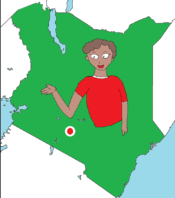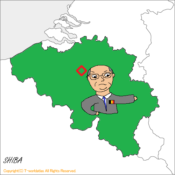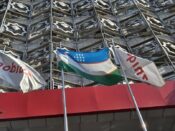ブラジルのリオデジャネイロは首都じゃないのになぜ有名? Why is Rio de Janeiro famous even though it’s not the capital of Brazil?
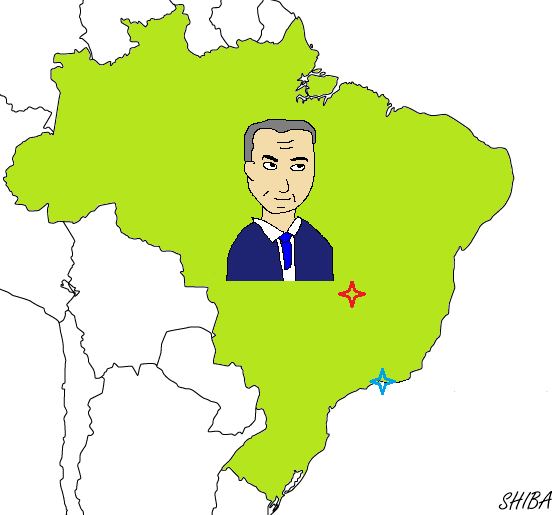
断崖絶壁に巨大なキリスト像が立ち、眼下には青い海が広がっている・・・そんなシーンをテレビで見たことがある人もいるでしょう。リオデジャネイロ(縮めてリオ)は、リゾートやカーニバルで有名な、ブラジルを代表する都市です。2016年には南米初のオリンピックが開かれ、話題となりました。
You may have seen on television a scene where a giant statue of Christ stands on the edge of a cliff, overlooking a vast blue sea below. Rio de Janeiro—often simply called Rio—is one of Brazil’s most iconic cities, famous for its beaches and carnival celebrations. In 2016, it hosted South America’s first Olympic Games, drawing global attention.
しかし、世界地図を広げてみると、この国の首都はリオデジャネイロではなく、ブラジリアとなっています。ではアメリカのニューヨークのように、ブラジル最大の都市かというと、そうでもありません。ブラジルで最大の人口を持つ都市は、リオから少し西にあるサンパウロ(約1000万人)で、リオは第2の都市(約700万人)です。首都でもなく最大都市でもない。にもかかわらず、リオデジャネイロの知名度がブラジルの都市でも際立っている理由は何なのでしょう。
However, when you look at a world map, you’ll notice that Brazil’s capital is not Rio de Janeiro but Brasília. And unlike New York in the United States, Rio is not the country’s largest city either. That distinction belongs to São Paulo, located a bit west of Rio, with a population of about ten million. Rio, with roughly seven million residents, is Brazil’s second-largest city. So, it is neither the capital nor the biggest city—yet it remains one of the most recognized cities in Brazil. Why is that?

もくじ
ブラジリアとリオデジャネイロ Brazilia and Rio de Janeiro
結論から先に言うと、リオデジャネイロはブラジルの“前の首都”なのです。首都がブラジリアに移ったのは1960年の事でした。後述するように、ブラジルが独立するのは1822年のことですが、実はそれ以前(植民地時代)からリオデジャネイロはブラジルの行政の中心でした。つまりブラジリアと比べ歴史の重みが違うのです。では、なぜ首都は移ったのか。ブラジルの歴史とともに見ていきましょう。
To get straight to the point, Rio de Janeiro is Brazil’s “former capital.” The capital was moved to Brasília in 1960. As will be explained later, Brazil gained independence in 1822, but even before that—during the colonial era—Rio de Janeiro was the administrative center of Brazil. In other words, compared to Brasília, Rio has a much deeper historical significance. So why was the capital relocated? Let’s explore this along with Brazil’s history.
一月の川 River of January
コロンブスがアメリカ大陸に到達してから8年後の1500年。ポルトガルの航海士カブラルが南米大陸東岸に上陸し、ここをポルトガル領としました。これがブラジルの始まりで、最初の首都(植民地の拠点)はサルヴァドールという街でした。
In 1500, eight years after Columbus arrived in the Americas, the Portuguese navigator Cabral landed on the eastern coast of South America, claiming it as Portuguese territory. This marked the beginning of Brazil, and the first capital (the base of the colony) was a city called Salvador.
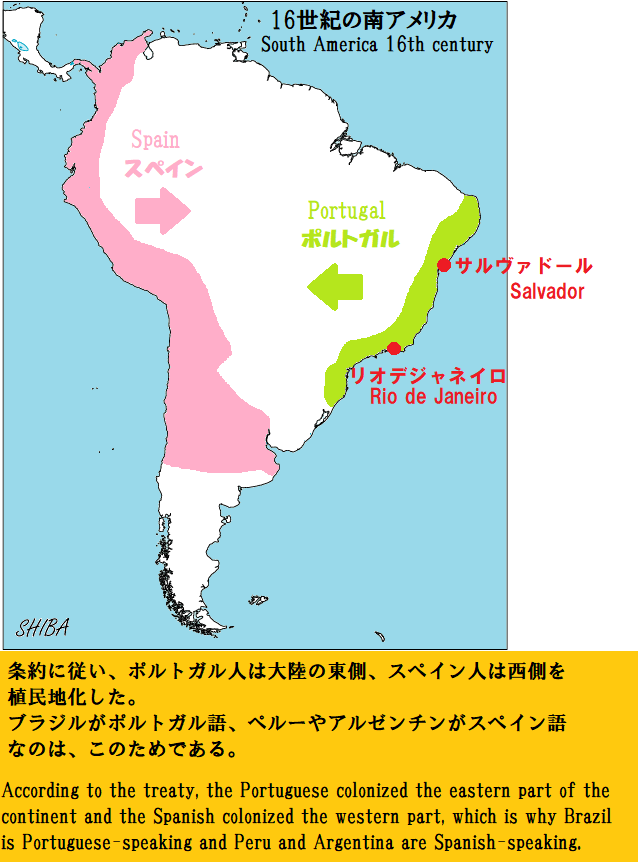
この後、ポルトガル人は海岸沿いに調査を続け、1502年の1月に港町としてうってつけの入り江を発見。ポルトガル語で「一月の川」を意味する 「リオ・デ・ジャネイロ」と命名します。無理やり英語で言えば、「River of January」といったところでしょうか。
After this, the Portuguese continued to explore along the coastline, and in January 1502, they discovered a bay ideal for a port town. They named it “Rio de Janeiro,” which means “River of January” in Portuguese.
砂糖の時代 金の時代 The Sugar Age and The Gold Age
ブラジルの国名は、染料に使われる樹木(パウ・ブラジル)に由来しています。植民地になった当初は他に目ぼしい輸出品が見つからなかったためです。 しかし16世紀半ば、ヨーロッパでコーヒーや紅茶が飲まれるようになると、砂糖の需要が高まり、サトウキビの生産でブラジルは発展していきました。
Brazil’s name comes from the Pau-Brasil tree, which was used for making dye. When it became a colony, there were no other valuable exports. But in the mid-1500s, as Europeans start drinking coffee and tea, the demand for sugar grew. Brazil developed by producing sugarcane.
18世紀には金山とダイヤモンド鉱山も発見され、ブラジルにもゴールドラッシュが到来しました。金、ダイヤモンドはいずれもサルヴァドールよりずっと南の、ミナス・ジェライス地方で産出され、経済の重心が南に移っていきます。そしてそれらの積出港として発展したのが、ミナス・ジェライス地方に近い港町、リオデジャネイロでした。
In the 18th century, gold and diamond mines were found, leading to a gold rush in Brazil. These were mined in Minas Gerais, far south of Salvador, shifting the country’s economy to the south. The port town that developed as the shipping port for these resources was Rio de Janeiro, located close to Minas Gerais.
1763年、遂にブラジル総督(国王の代理人的存在)がサルヴァドールからリオデジャネイロに移り、この都市はブラジルの首都ととして、その第一歩を踏み出しました。
In 1763, the Governor-General of Brazil (the representative of the King) finally moved from Salvador to Rio de Janeiro, and this city took its first steps as the capital of Brazil.

ポルトガルからの独立 Independence from Portugal
18世紀末、ヨーロッパではフランス革命が起き、その混乱の後、ナポレオンが各地を攻撃します。それはポルトガルも例外ではありませんでした。1807年ポルトガル王家はナポレオン軍の侵攻を察知し、国を脱出。大西洋を越えて植民地ブラジルに亡命しました。この結果、リオデジャネイロは、リスボンに代わる「ポルトガルの首都」にとなります。
At the end of the 18th century, the French Revolution broke out in Europe, and after the ensuing turmoil, Napoleon attacked various regions. Portugal was no exception. In 1807, the Portuguese royal family, sensing Napoleon’s invasion, fled the country and crossed the Atlantic to take refuge in their colony, Brazil. As a result, Rio de Janeiro essentially became the “capital of Portugal” in place of Lisbon.
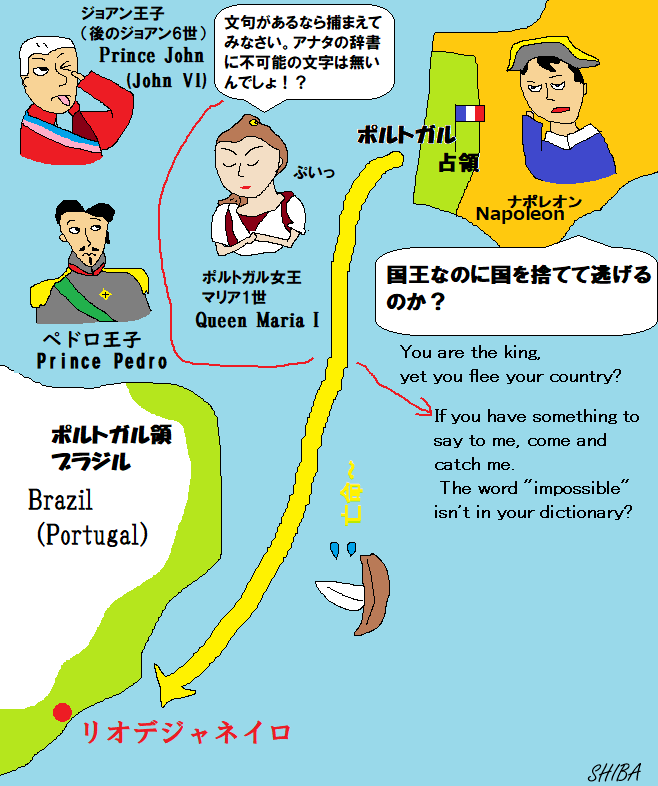
ナポレオンの倒れた後の1815年には国王(当時は女王マリア1世)のいる場所が植民地であってはならないということで、ブラジルは「ポルトガル本国の一部」(つまりポルトガルと同等の扱い)に格上げされます。しかし1820年にポルトガルで革命が起こると、ブラジルでポルトガル王となったジョアン6世も本国に帰るのですが、こうなるとまたブラジルが植民地に格下げされてしまうのではないか。そう思ったブラジルの人々は、帰国しなかった王子(ペドロ皇太子)を君主につけて、1822年独立を宣言しました。植民地に戻るくらいなら、もうポルトガルから独立してしまおうという(大胆な)発想です。
After Napoleon’s fall, in 1815, it was deemed inappropriate for the monarch (at the time, Queen Maria I) to reside in a colony, so Brazil was elevated to the status of “part of Portugal proper” (meaning it was treated on par with Portugal itself). However, when a revolution broke out in Portugal in 1820, King João VI, who had become the Portuguese monarch in Brazil, returned home—but this raised concerns that Brazil might be downgraded to a colony again. Wishing to avoid this, the people of Brazil made the prince who had remained behind (Prince Pedro) their monarch and declared independence in 1822. This was a bold move—if they were to become a colony again, they would rather become independent from Portugal.
無論ポルトガル政府は反対したのですが、ちょうどこの頃、アルゼンチンやコロンビアなど他の南米諸国もスペインからの独立を達成していたこともあり、この独立運動は最終的に成功しました。
Of course, the Portuguese government opposed this, but around the same time, other South American countries like Argentina and Colombia were also achieving independence from Spain, and ultimately Brazil’s independence movement succeeded.
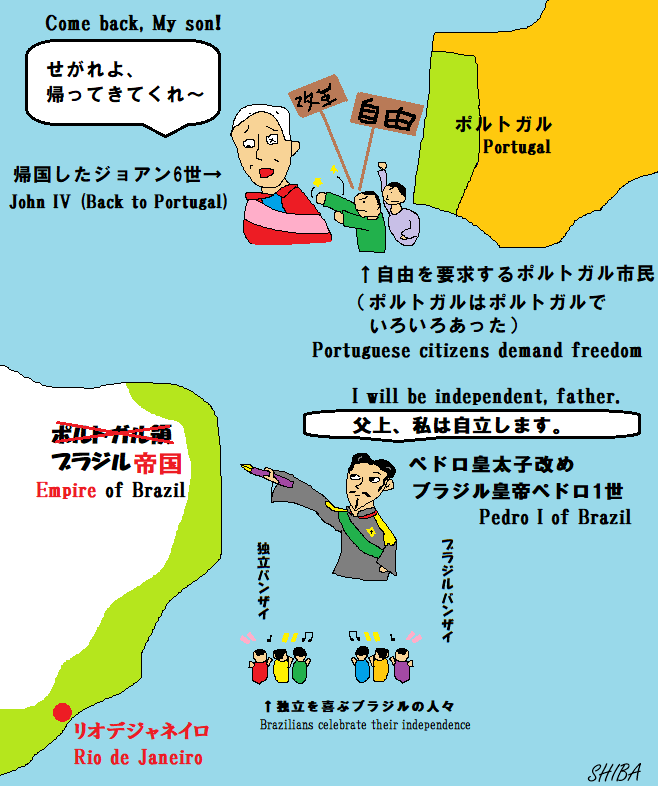
救世主現る The Savior
話をブラジル経済に戻します。先ほどお話しした砂糖は、19世紀までにはキューバなどカリブの島々との競争に負け、金もダイヤモンドも量が少なかったため、いずれも長くブラジルを支えることはできませんでした。
そんなブラジル経済を救ったのが、18世紀にもたらされていたコーヒーです。19世紀から本格栽培されたコーヒーは、特にサンパウロ州の土と相性バツグンで、盛んに栽培、輸出されました。
To return to the topic of Brazil’s economy: the sugar that was mentioned earlier lost out to competition from Cuba and other Caribbean islands by the 19th century, and Brazil also could not rely for long on gold or diamonds, since their quantities were too limited. What ultimately rescued Brazil’s economy was coffee, which had been introduced as early as the 18th century. Coffee began to be cultivated seriously in the 19th century, especially in São Paulo state, where the soil was exceptionally well-suited for it, leading to vigorous production and export.
19世紀はヨーロッパの市民の間でも活発に議論が交わされた時期で、(お酒と異なり)頭をすっきりさせるコーヒーは人気でした。そのブームにうまく乗ったブラジルは、発展を続けることができたというワケ。また、コーヒーに関する企業の拠点として、サンパウロには多くの人が集まるようになり、最終的には同国最大の経済都市へと成長しました。(現在ではブラジルどころか、南半球でも最大規模の都市のひとつとなっています)
The 19th century was also a time of lively debate among citizens in Europe, and coffee—unlike alcohol, which dulls the mind—was popular for its invigorating effect. Riding the wave of this boom, Brazil continued to develop. Additionally, São Paulo became a hub for coffee-related enterprises, drawing many people and eventually transforming into the country’s largest economic center. Today, São Paulo is not only the largest city in Brazil, but also one of the largest cities in the Southern Hemisphere.
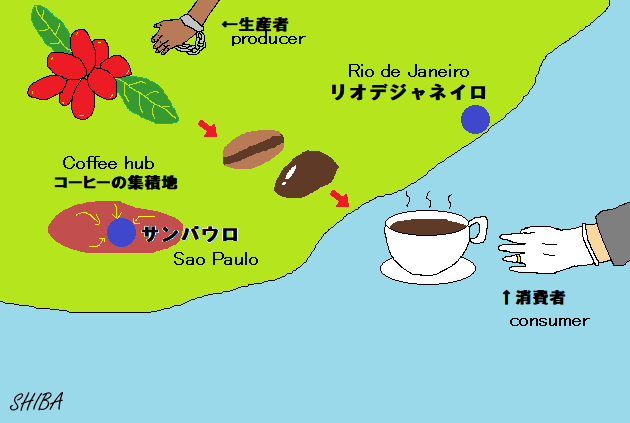
しかしサトウキビにしても、コーヒーにしても、栽培の労働力としてこき使われたのは、アフリカから連れて来られた黒人奴隷やその子孫でした。このためブラジルは奴隷解放が最も遅い国のひとつでもありました。19世紀末、時の皇帝ペドロ2世は遂に奴隷解放宣言を出しますが、これに反対する人の支持を失い、1889年には君主制自体が廃止。大統領をトップに据えた「共和国」となりました。
However, whether it was sugarcane or coffee, the labor force for cultivation was made up largely of enslaved Africans and their descendants. This is why Brazil was one of the last countries to abolish slavery. In the late 19th century, Emperor Pedro II finally issued a declaration of emancipation, but in doing so lost the support of those opposed to abolition, and in 1889 even the monarchy itself was abolished. Brazil then became a republic, led by a president.
美しき港町 A Beautiful Port Town
20世紀に入っても、ブラジルはコーヒーやサトウキビといった農業を中心に発展しました。なにしろ世界第5位の面積を誇る国ですから、土地は有り余るほどあったといえましょう。奴隷が解放されてからは、移民などの「安価な労働力」が用いられ、そこには明治維新を迎えた日本人(日系人)も多くやってきました。
Even into the 20th century, Brazil continued its development centered on agriculture, especially coffee and sugarcane. As the country boasts the fifth largest land area in the world, it can be said that there was plenty of land available. After the emancipation of slaves, immigrants and other sources of “cheap labor” were used, including a large number of Japanese (and Japanese-Brazilians) who came after the Meiji Restoration.
政治的にはヴァルガス大統領の長期独裁政権なんかもありましたが、第1次、第2次世界大戦でも直接戦場になることはなく(兵士が派遣され犠牲になることはあった)、ヨーロッパやアジアと比べると大きな変化はありませんでした。そして、この間首都はずっとリオデジャネイロでした。首都であり、港町でもあるこの都市はまさにブラジルの正面玄関であり、都市の景観にも力が入ったのか、後には世界三大美港の一つにも数えられるようになります。1931年には、あの有名なコルコバードのキリスト像も完成しました。
Politically, there was also a long-term dictatorship under President Vargas, but during World War I and World War II, the country itself was never a direct battlefield (although soldiers were dispatched and casualties did occur), so compared to Europe and Asia, there were no major transformations. During this period, Rio de Janeiro remained the capital throughout. As both the capital and a port city, Rio de Janeiro was quite literally Brazil’s main gateway, and perhaps because of this, much energy went into beautifying the urban landscape; eventually, the city came to be regarded as one of the world’s three great natural harbors. In 1931, the famous Christ the Redeemer statue on Corcovado was also completed.
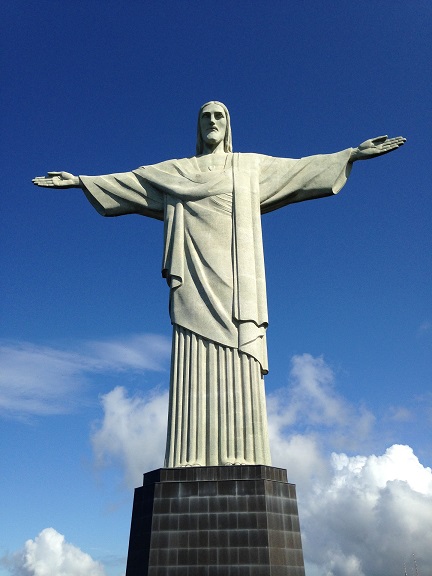
※写真はPIXABAY様より拝借
世界遺産の首都 A World Heritage-listed capital
しかし、リオにしろ、サルヴァドールにしろ、サンパウロにしろ、ブラジルの主たる都市はいずれも海に近いところに位置しており、内陸部と沿岸部との間には大きな「差」が生じていきました。また、人口の増加と共に都市化(農村からの移住)も進み、多くの貧しい人々がリオの郊外にスラム街を形成(ファベーラと呼ばれています)していきます。更に自動車の普及は、渋滞などの交通問題を引き起こしました。
However, whether it is Rio, Salvador, or São Paulo, all of Brazil’s major cities are located near the coast, creating a significant gap between the inland and coastal regions. Along with population growth, urbanization progressed as people migrated from rural areas to the cities. Many poor residents built slums on the outskirts of Rio—known as favelas. In addition, the widespread use of automobiles led to traffic congestion and other transportation problems.
これらの問題を一挙に解決しようとしたのが、新しい首都の建設でした。車社会に対応した近未来的な都市を、開発の遅れている内陸部に建設すれば、ブラジル社会の更なる発展にはずみがつくと思ったのでしょう。時の大統領クビシェキは、1960年、新首都ブラジリアを建設。その中心部は交差点をすべて立体交差にし、渋滞を極力生まない構造になっていました。また、ブラジリアの街並みを上から見ると、ジェット機のような形をしています。これも、ブラジルが「未来にはばたく」というメッセージが込められているとのことです。
To address all of these issues at once, the government decided to build a new capital. The idea was that constructing a futuristic city adapted to automobile society in the underdeveloped inland region would give new momentum to Brazil’s growth. Under President Kubitschek, the new capital Brasília was completed in 1960. Its central area was designed entirely with grade-separated intersections to minimize traffic congestion. When viewed from above, the cityscape of Brasília resembles the shape of a jet aircraft—a symbolic design conveying the message that Brazil was “soaring into the future.”
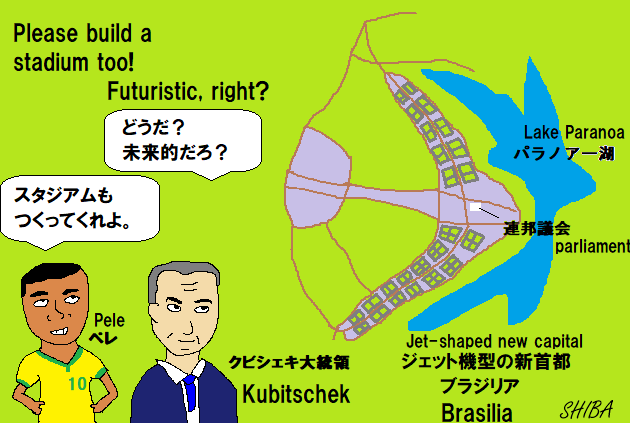
この近未来都市は、1982年ユネスコの世界文化遺産に登録されました。ただしそれだけに、ブラジリアの建設費用は莫大でした。皮肉なことに、新しい首都建設によって政府は財政難に陥り(まあ、原因はそれだけではないのですが)、一時は軍事政権が出現するなど、不安定な時代を迎えることになります。
This futuristic city was registered as a UNESCO World Cultural Heritage Site in 1982. However, building Brasília required enormous costs. Ironically, the expenses of constructing the new capital plunged the government into financial difficulties (though that was not the only cause), and the country faced an unstable period that even saw the emergence of a military regime.
問題解決せず Problems not Solved
さて、首都移転から60年弱。ブラジリアはその後も発展していき、現在の人口は200万を超えています。しかし一方でリオデジャネイロの人口増はブラジリアの比ではなく、スラム街による治安悪化はなおも深刻です。
About sixty years have passed since the capital’s relocation. Brasília has continued to develop and now has a population of over two million. On the other hand, the population growth of Rio de Janeiro far outpaces that of Brasília, and the worsening security in its slum areas remains a serious problem.
また、アマゾンの開発による環境破壊など、内陸部の開発にも賛否があり、それがブラジルの発展にどれだけ役に立ったかはビミョーな所です。クビシェキ大統領の思いは未だ中途半端な形でしか実現しておらず、ブラジリアの”地位”も、いまだリオを越えるものではないのが現状のようです。
Moreover, the development of the Amazon has led to environmental destruction, sparking controversy over whether inland development has truly benefited Brazil’s growth. President Kubitschek’s vision has only been partially realized, and even today Brasília’s “status” has yet to surpass that of Rio.
リオの魅力とは The charm of Rio
首都の座を明け渡したとはいえ、リオデジャネイロにはキリスト像も、美しい自然も残っています。またカーニバルに代表されるように、この都市はブラジル文化の中心地でもあります。こうした魅力は今も昔も変わらず、多くの人を惹きつけています。そのパワーこそが、リオデジャネイロがブラジルを代表する都市として認識されている理由なのでしょう。
Although Rio de Janeiro relinquished its role as the capital, it still retains its famous Christ statue and stunning natural scenery. The city, symbolized by its world-renowned Carnival, continues to serve as the cultural heart of Brazil. These enduring attractions keep drawing people in—and this vital energy is precisely why Rio de Janeiro is still regarded as Brazil’s representative city.
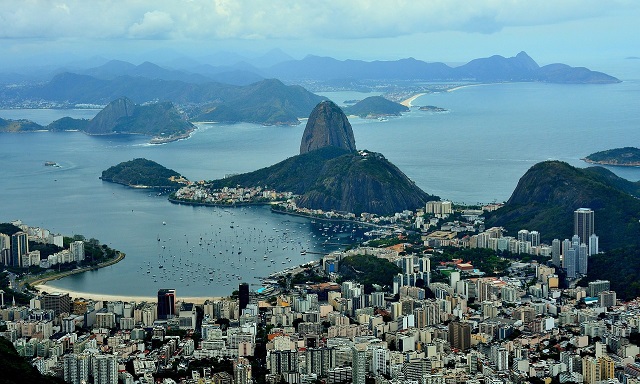
※写真はPIXABAY様より拝借



